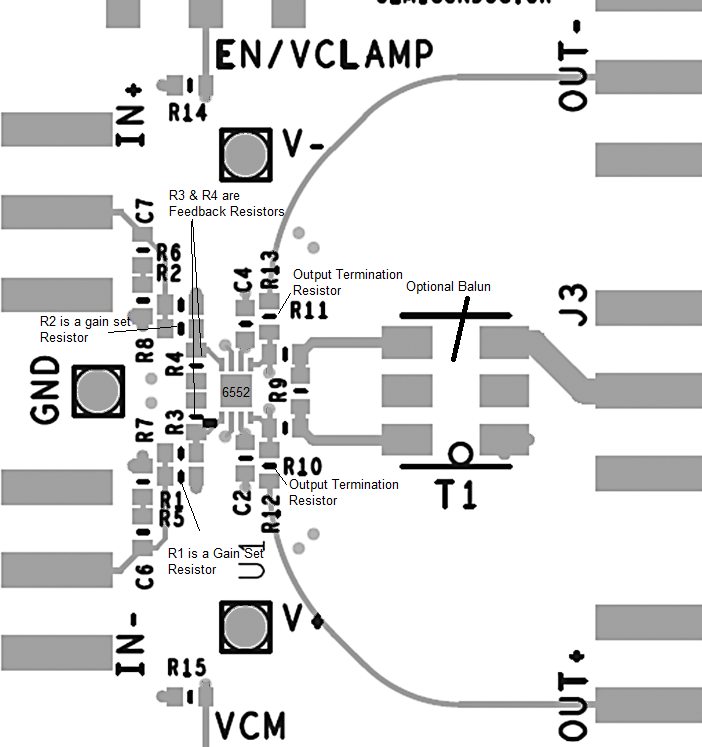SNOSAX9J April 2007 – April 2016 LMH6552
PRODUCTION DATA.
- 1 Features
- 2 Applications
- 3 Description
- 4 Revision History
- 5 Pin Configuration and Functions
- 6 Specifications
- 7 Detailed Description
-
8 Application and Implementation
- 8.1 Application Information
- 8.2 Typical Applications
- 9 Power Supply Recommendations
- 10Layout
- 11Device and Documentation Support
- 12Mechanical, Packaging, and Orderable Information
Package Options
Mechanical Data (Package|Pins)
Thermal pad, mechanical data (Package|Pins)
Orderable Information
10 Layout
10.1 Layout Guidelines
The LMH6552 is a very high performance amplifier. In order to get maximum benefit from the differential circuit architecture board layout and component selection is very critical. The circuit board must have a low inductance ground plane and well bypassed broad supply lines. External components must be leadless surface mount types. The feedback network and output matching resistors must be composed of short traces and precision resistors (0.1%). The output matching resistors must be placed within 3 or 4 mm of the amplifier as must the supply bypass capacitors. Refer to Power Supply Bypassing for recommendations on bypass circuit layout. Evaluation boards are available free of charge through the product folder on ti.com.
By design, the LMH6552 is relatively insensitive to parasitic capacitance at its inputs. Nonetheless, ground and power plane metal must be removed from beneath the amplifier and from beneath RF and RG for best performance at high frequency.
With any differential signal path, symmetry is very important. Even small amounts of asymmetry can contribute to distortion and balance errors.
10.2 Layout Example
 Figure 55. Layout Schematic
Figure 55. Layout Schematic
10.3 Thermal Considerations
The WSON package is designed for enhanced thermal performance and features an exposed die attach pad (DAP) at the bottom center of the package that creates a direct path to the PCB for maximum power dissipation. The DAP is floating and is not electrically connected to internal circuitry. Compared to the traditional leaded packages where the die attach pad is embedded inside the molding compound, the WSON reduces one layer in the thermal path.
The thermal advantage of the WSON package is fully realized only when the exposed die attach pad is soldered down to a thermal land on the PCB board with thermal vias planted underneath the thermal land. The thermal land can be connected to any power or ground plane within the allowable supply voltage range of the device. Based on thermal analysis of the WSON package, the junction-to-ambient thermal resistance (θJA) can be improved by a factor of two when the die attach pad of the WSON package is soldered directly onto the PCB with thermal land and thermal vias are 1.27 mm and 0.33 mm respectively. Typical copper via barrel plating is 1 oz, although thicker copper may be used to further improve thermal performance.
For more information on board layout techniques, refer to Application Note 1187 Leadless Lead Frame Package (LLP). This application note also discusses package handling, solder stencil and the assembly process.
10.4 Power Dissipation
The LMH6552 is optimized for maximum speed and performance in the small form factor of the standard SOIC package, and is essentially a dual channel amplifier. To ensure maximum output drive and highest performance, thermal shutdown is not provided. Therefore, it is of utmost importance to make sure that the TJMAXof 150°C is never exceeded due to the overall power dissipation.
Follow these steps to determine the maximum power dissipation for the LMH6552:
- Calculate the quiescent (no-load) power:
- VS = V+ - V−. (Be sure to include any current through the feedback network if VOCM is not mid-rail.)
- Calculate the RMS power dissipated in each of the output stages:
- VOUT and IOUT are the voltage and the current measured at the output pins of the differential amplifier as if they were single ended amplifiers and VS is the total supply voltage
- Calculate the total RMS power:
where
where
The maximum power that the LMH6552 package can dissipate at a given temperature can be derived with the following equation:
where
- TAMB = Ambient temperature (°C)
- θJA = Thermal resistance, from junction to ambient, for a given package (°C/W)
- For the SOIC package θJA is 150°C/W
- For WSON package θJA is 58°C/W
NOTE
If VCM is not 0V then there is quiescent current flowing in the feedback network. This current must be included in the thermal calculations and added into the quiescent power dissipation of the amplifier.
10.5 ESD Protection
The LMH6552 is protected against electrostatic discharge (ESD) on all pins. The LMH6552 can survive 2000 V Human Body model and 200 V Machine model events. Under normal operation the ESD diodes have no affect on circuit performance. There are occasions, however, when the ESD diodes are evident. If the LMH6552 is driven by a large signal when the device is powered down the ESD diodes conduct. The current that flows through the ESD diodes either exits the chip through the supply pins or flows through the device, hence a chip can be powered up with a large signal applied to the input pins. Using the shutdown mode is one way to conserve power and still prevent unexpected operation.